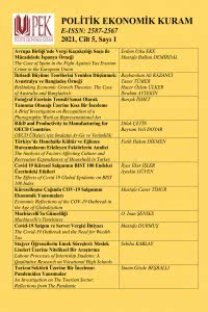Turizm Sektörünün Çevresel Kuznets Eğrisi Açısından Değerlendirilmesi: Türkiye Örneği
Çalışmanın amacı Türkiye turizm sektörünün çevresel Kuznet Eğrisi açısından değerlendirmektir. Bu bağlamda turizm sektörü ve çevre ilişkisi 4 değişken üzerinden incelenmiştir. Değişkenler karbondioksit salınımı, GSYH, turist sayısı ve enerji tüketimidir. Analiz kısmında ise yıllık veriler kullanılmış olup 1980-2019 yılları arası baz alınarak zaman serileri yöntemi kullanılmıştır. Zaman serisi analizi kapsamında tüm değişkenlerin durağanlık özellikleri, Arttırılmış Dickey-Fuller Birim Kök Testi ile incelenmiştir. Durağan olmayan değişkenler için Johansen eş bütünleşme testi ve değişkenler arasındaki nedensellik ilişkilerinin tespiti için Granger Nedensellik modeli kullanılmıştır. Son olarak, VAR modelinin temel varsayımları sağladığı tespit edilmiştir. Eşbütünleşme analizi sonuçlarına göre 1 gecikmeli VAR modeline göre seriler arasında en az 1 tane eş bütünleşme vektörü olduğu tespit edilmiştir. Seriler arasındaki nedensellik ilişkisi ise Granger nedensellik analiziyle test edilmiştir. Granger nedensellik analizi sonucunda ise turist sayısı ve karbondioksit salınımı arasında çift yönlü nedensellik ilişkisi olduğu görülmüştür. Turist sayısındaki artış karbondioksit salınımını arttırmaktadır. Bununla birlikte karbondioksit salınımının artmasının sonucu olarak turist sayısındaki artış gözlemlenmektedir. Bunun nedeni olarak da tüketim olanaklarının artması turist sayısını arttırıp bunun da karbondioksit salınımını arttırdığı düşünülmektedir. Enerji kullanımı ve karbondioksit salınımı arasında tek yönlü nedensellik ilişkisi olduğu gözlemlenmiş olup enerji kullanımının artmasının karbondioksit salınımını arttırdığı görülmektedir. Buradan yola çıkarak turist sayısı ve GSYİH arasında tek yönlü nedensellik ilişkisi gözlemlenmiş olup turist sayısının artması GSYİH’ ı arttırdığını ifade edebiliriz. Türkiye’de turizm sektörü Çevresel Kuznet Eğrisi açısından incelendiğinde elde edilen sonuçlar, turizm sektörü GSYH’yı olumlu katkısı olsa da çevreye zarar vermektedir. Çevresel Kuznet Eğrisi ile turizm sektörünü Türkiye bağlamında inceleyen çok sınırlı sayıda çalışma bulunmaktadır. Çalışmanın sonuçlarının alan yazına önemli katkı sağlayacağı düşünülmektedir.
EVALUATION OF TOURISM SECTOR IN TERMS OF ENVIRONMENTAL KUZNET CURVE PERSPECTIVE: THE CASE OF TURKEY
Within the scope of the study, the validity of the Environmental Kuznets Curve Hypothesis for Turkey was examined. In this context, the relationship between the tourism sector and the environment has been examined over 4 variables. The variables are carbon dioxide emissions, GDP, number of tourists and energy consumption. In the analysis part, annual data was used and the time series method was used based on the years 1980-2019. Within the scope of time series analysis, stationarity properties of all variables were examined with Augmented Dickey-Fuller Unit Root Test. Johansen cointegration test for non-stationary variables and Granger Causality model was used to determine causality relationships between variables. Finally, it has been found that the VAR model provides the basic assumptions. According to the results of the cointegration analysis, it has been determined that there is at least 1 cointegration vector between the series according to the 1-delayed VAR model. The causality relationship between the series was tested with Granger causality analysis. . As a result of the Granger causality analysis, it was seen that there is a bidirectional causality relationship between the number of tourists and carbon dioxide emissions. The increase in the number of tourists increases the carbon dioxide emissions. However, as a result of the increase in carbon dioxide emissions, an increase in the number of tourists is observed. The reason for this is that the increase in consumption opportunities increases the number of tourists, which in turn increases carbon dioxide emissions. It has been observed that there is a one-way causality relationship between energy use and carbon dioxide emissions, and it is observed that an increase in energy use increases carbon dioxide emissions. From this point of view, a one-way causality relationship has been observed between the number of tourists and GDP, and we can say that the increase in the number of tourists increases the GDP. When the tourism sector in Turkey is examined in terms of the Environmental Kuznet Curve, the results obtained, although the tourism sector contributes positively to the GDP, harms the environment. There are very limited studies examining the Environmental Kuznet Curve and the tourism sector in the context of Türkiye. It is thought that the results of the study will make an important contribution to the literature.
___
- Albayrak, E. N., ve Gökçe, A. (2015). Ekonomik Büyüme ve Çevresel Kirlilik İlişkisi: Çevresel Kuznets Eğrisi ve Türkiye Örneğ. Sosyal Bilimler Araştırma Dergisi, 4(2), 279-301.
- Anser, M. K., Yousaf, Z., Nassani, A. A., Abro, M. M. Q., & Zaman, K. (2020). International tourism, social distribution, and environmental Kuznets curve: evidence from a panel of G-7 countries. Environmental Science and Pollution Research, 27, 2707-2720.
- Atici, C., ve Kurt F. (2007). Türkiye'nin dış ticareti ve çevre kirliliği: Çevresel Kuznets Eğrisi yaklaşımı. Tarım Ekonomisi Dergisi, 13(1 ve 2), 61-69.
- Bayazıt, S. (2018). İklim değişikliği ve turizmin Türkiye iç turizmi göz önünde bulundurmak. Anadolu: Turizm Araştırmaları Dergisi, 29(2), 221-231.
